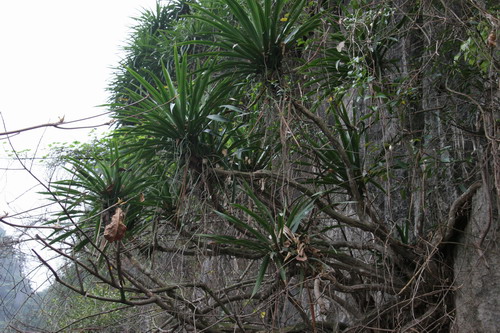Dracaena cambodiana Pierre ex Gagnepain (Asperagaceae), commonly known as the dragon blood tree, is a vulnerable species and generally distributed in the escarpments of island-like limestone mountains in paleotropical Southeastern Asia. It is a national second class protected plant in China. As representative of dragon trees in Asia, D. cambodiana serves as an ideal model species to test the biodiversity-original hypotheses of plant species in Paleotropics.
Dr. LI Qiaoming and her students of Xishangbanna Tropical Botanical Garden (XTBG) conducted a study on Dracaena cambodiana in order to (i) illustrate the genetic diversity, gene flow and past population demographics using cpDNA and nSSR; (ii) determine the ancestral populations and past migration patterns through phylogeographic analysis of cpDNA; (iii) date the genetic divergence under different molecular clock methods.
The researchers analyzed nucleotide sequence data of two chloroplast DNA (cpDNA: atpB-rbcL and trnD-trnT) regions and genotype data of six nuclear microsatellites from 15 populations (140 and 363 individuals, respectively) distributed in Indochina Peninsular and Hainan Island to infer the patterns of genetic diversity and phylogeographic structure. The population bottleneck and genetic drift were estimated based upon nuclear microsatellites data using the software programs BOTTLENECK and 2MOD. The lineage divergence times and past population dynamics based on cpDNA data were estimated using coalescent-based isolation-with-migration (IMa) and BEAST software programs.
Their study results indicated that the present distribution of genetic diversity in D. cambodiana was an outcome of Tertiary dispersal and rapid divergence during the Quaternary period under limited gene flow influenced by the uplift of Himalayan-Tibetan Plateau and Quaternary climatic fluctuations respectively. The evolutionary processes such as extinction-recolonization due to climate change during the Pleistocene may have contributed to the fast diversification in D. combodiana.
The study entitled “Tertiary Origin and Pleistocene Diversification of Dragon Blood Tree (Dracaena cambodiana-Asparagaceae) Populations in the Asian Tropical Forests” has been published in PLoS ONE 8(4): e60102. doi:10.1371/journal.pone.0060102

Dragon blood tree (Dracaena cambodiana-Asparagaceae) in a tropical forest (Image by ZHAO Jianli)

